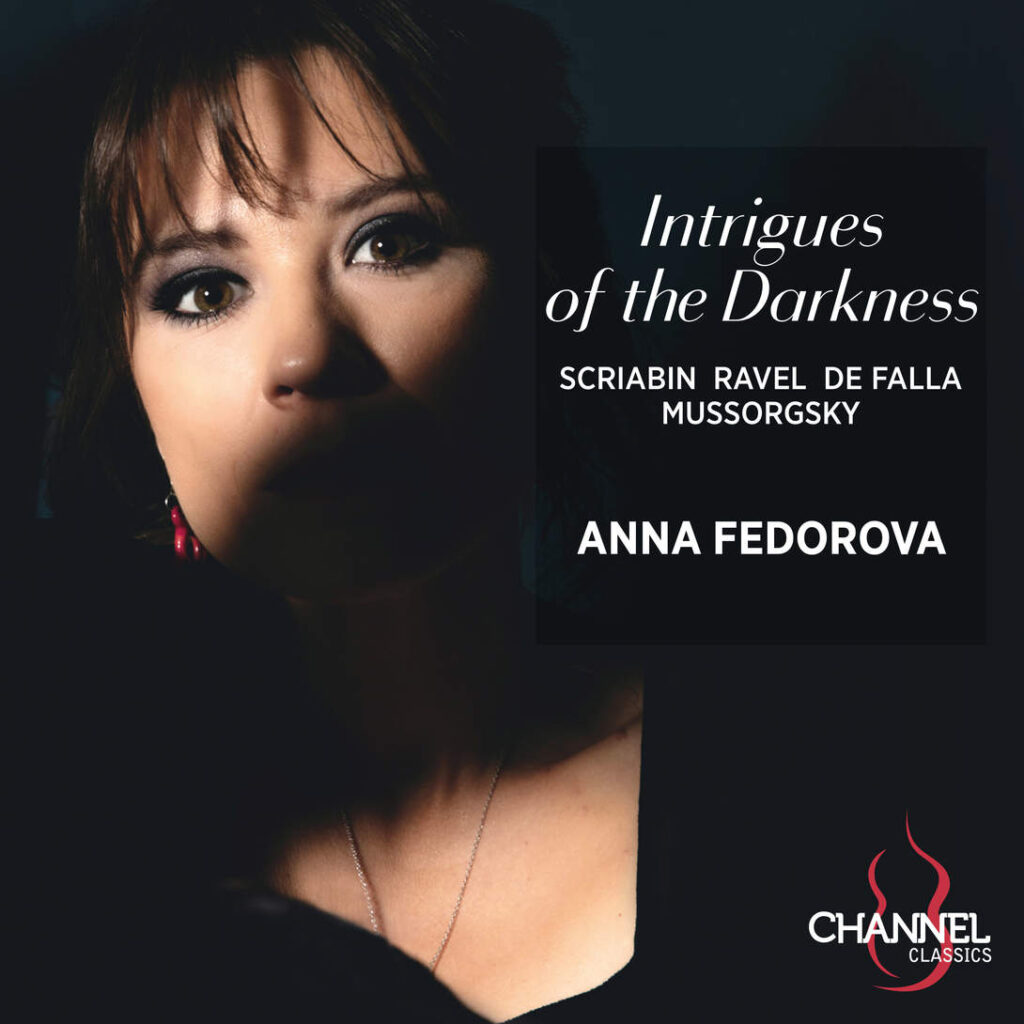Op haar nieuwe album Intrigues of the Darkness verkent pianiste Anna Fedorova de werking van licht en donker in composities van Scriabin, Ravel, De Falla en Mussorgsky.
English version below
Pianiste Anna Fedorova heeft een fraaie collectie samengesteld voor haar nieuwe album Intrigues of the Darkness. Composities met een grote zeggingskracht.
Het album opent met de Piano Sonate No. 9 van Scriabin. Een één-delig werk dat hij componeerde in de laatste jaren van zijn leven. Het wordt ook wel De Zwarte Mis-Sonate genoemd en is door de vele dissonanten, chromatiek en dynamische verschillen een zeer grillig werk. Het stuk is complex en draagt een energieke spanning in zich. Fedorova voert het uit met een fraaie en natuurlijke souplesse.
Dat komen we ook tegen in de compositie Gaspard de la nuit van Ravel. Een zeer gecompliceerd drie-delig werk voor piano-solo, dat gebaseerd is op drie gedichten van Aloysius Bertrand, een Franse dichter uit het midden van de 19de eeuw. In het 1ste deel, Odine, wordt de nimf, die mannen verleidt, muzikaal vertaald naar o.a. twinkelende arpeggio’s, terwijl het 2de deel, Le Gibet, zich manifesteert met een thema dat wordt omringd met akkoorden. In het 3de deel, Scarbo, horen we de duivelse dwerg die als een spindel door de kamer tolt. Gaspard de la nuit is een van moeilijkste stukken uit het piano-solorepertoire. Ravel was geïnspireerd door het werk Islamej van de Russische componist Balakirev, de oprichter van het Machtige Hoopje, waar naast Balakirev ook Borodin, Cui, Mussorgsky en Rimski-Korsakov toe behoorden.
De derde compositie op het album, het aanvankelijk voor ballet geschreven El Amor Brujo van De Falla, handelt over de liefde van een Roma-meisje die haar spirituele krachten gebruikt om haar doel te bereiken. De compositie heeft veel kenmerken van de Andalusische muziek, waaronder het gebruik van glissandi, ferme ritmiek en dynamiek.
Pictures at an Exhibition is, naast de opera Boris Godunov, de bekendste compositie van Mussorgsky. Hij schreef het werk naar aanleiding van een schilderijententoonstelling van een goede vriend en schilder Victor Hartmann, die al op 39 jarige leeftijd overleed. Mussorgsky componeerde in slechts drie weken deze prachtige 16-delige compositie, die jaren later, in 1922, door Ravel is georkestreerd.
Pianiste Anna Fedorova bezit het talent, de techniek en het inlevingsvermogen om deze virtuoze werken van Scriabin, Ravel, De Falla en Mussorgsky op temperamentvolle wijze uit te voeren. Zij geeft de muziek een zuivere en oprechte diepgang die opzienbarend en hartveroverend is.
- Klik hier voor Silhouttes
- Klik hier voor Storyteller
- Klik hier voor Fathers and Daughters
- Klik hier voor Dutch Hidden Gems
English version
On her new album Intrigues of the Darkness, pianist Anna Fedorova explores the effects of light and dark in compositions by Scriabin, Ravel, De Falla and Mussorgsky.
Pianist Anna Fedorova has compiled a beautiful collection for her new album Intrigues of the Darkness. Compositions with great expressiveness.
The album opens with the Piano Sonata No. 9 by Scriabin. A one-part work that he composed in the last years of his life. It is also called The Black Mass Sonata and is a very capricious work due to the many dissonances, chromaticism and dynamic differences. The piece is complex and carries an energetic tension within it. Fedorova performance is with a great natural flexibility.
We also encounter this in the composition Gaspard de la nuit by Ravel. A very complicated three-part work for piano solo, based on three poems by Aloysius Bertrand, a French poet from the mid-19th century. In the first part, Odine, the nymph who seduces men is musically translated into, among other things, twinkling arpeggios, while the second part, Le Gibet, manifests itself with a theme surrounded by chords. In the third part, Scarbo, we hear the devilish dwarf who spins through the room like a spindle. Gaspard de la nuit is one of the most difficult pieces in the solo piano repertoire. Ravel was inspired by the work Islamej by the Russian composer Balakirev, the founder of the Mighty Five, to which, besides Balakirev, Borodin, Cui, Mussorgsky and Rimsky-Korsakov also belonged.
The 3th composition, El Amor Brujo by De Falla, originally written for ballet, deals with the love of a Roma girl who uses her spiritual powers to achieve her goal. The composition has many characteristics of Andalusian music, including the use of glissandi, firm rhythm and dynamics.
Pictures at an Exhibition is, next to the opera Boris Godunov, Mussorgsky’s best-known composition. He wrote the work in response to a painting exhibition by his good friend and painter Victor Hartmann, who died at the age of 39. Mussorgsky composed this wonderful 16-part composition in just a few weeks, which was orchestrated by Ravel years later, in 1922.
Pianist Anna Fedorova possesses the talent, technique and empathy to perform these virtuoso works by Scriabin, Ravel, De Falla and Mussorgsky in a spirited manner. She gives the music a pure and sincere depth that is sensational and heart-warming.
- Click here for Silhouttes
- Click here for Storyteller
- Click here for Fathers and Daughters
- Click here for Dutch Hidden Gems
*Anna Fedorova: Intrigues of the Darkness (Channel Classics)
© Mattie Poels.


Geen reacties